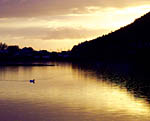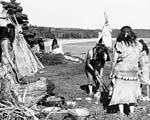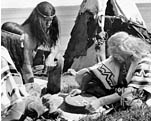History of Eskasoni
The word Eskasoni is derived from a Mi'kmaq word "We'kwistoqnik." Literally translated, this word means "where the fir trees are plentiful". Eskasoni was first charted by the Surveyor-General of Cape Breton in 1832. At that time, there were very few families living in the Eskasoni area, compared with the nearly 4000 residents of today. Two years later, in 1834, Eskasoni officially became a reserve, consisting of approximately 2800 acres of land.
During the 1800s there were many Native communities around Cape Breton. Eskasoni was at that time a relatively small, isolated community. According to census reports, in 1871 there were only 125 people living in Eskasoni. By 1891 the population of Eskasoni had declined to 80 residents. With such small population figures from 100 years ago, one might wonder how this community survived at all, let alone became the largest Native community in the Atlantic Provinces.
The primary reason for the extraordinary growth of Eskasoni occurred during the 1940s. In 1942 the Department of Indian Affairs introduced a policy to centralize Native people. In Nova Scotia, all Native people were to be relocated to two locations: Shubenacadie in mainland Nova Scotia, and Eskasoni on Cape Breton Island. The motives for this decision may have been acceptable, but the results were not good. While the population of Eskasoni did grow and the community became larger than it had ever been, there were problems.
Overcrowding, poor housing, substance abuse, and little or no economic opportunities for the residents were just some of the problems encountered in Eskasoni. Although the government promised aid and housing, there simply were not enough resources or houses to support the influx of people. Many Natives, after being relocated, felt a desire to return to their homes. To ensure this did not happen, Indian Agents would often destroy Native homes once they had been relocated to Eskasoni.
During the 1950s, Eskasoni, along with many other Native communities in Nova Scotia, began the process of taking control of their own affairs. A Band Council was established in 1958. This was a major step towards controlling their own affairs, but Eskasoni would take other great steps as well.
Today, Eskasoni takes pride in who they are and how far they've gotten. Eskasoni is the largest Aboriginal community in all of Atlantic Canada. Deeply rooted within Eskasoni is the Mi'kmaq culture. Eskasoni is the largest Mi'kmaq speaking community in the world with close ties to Cape Breton Gaelic and French traditions.
The community of Eskasoni has a young population and has a proud history of supporting its young population with events that promote a healthy and active lifestyle. With a dedication to improving the lives of its future generation, the Eskasoni leadership and community members know that education is the key to change but must maintain a balance of culture and be respectful of its ecosystem based on concepts of shared responsibility.
Over the last several years, Eskasoni has made great strides in developing a solid infrastructure on which to grow and prosper. The community has its own community operated school system from kindergarten to grade 12 and has one of the best community First Nation health centers in Canada. Economic development is growing and new development is welcomed in the community. Eskasoni has it's own Supermarket (Foodland), a thriving band owned fishery (Crane Cove Seafoods), a newly renovated community rink and the emergence of Eskasoni Tourism. The future is full of endless potentials.
This is Our Eskasoni.





